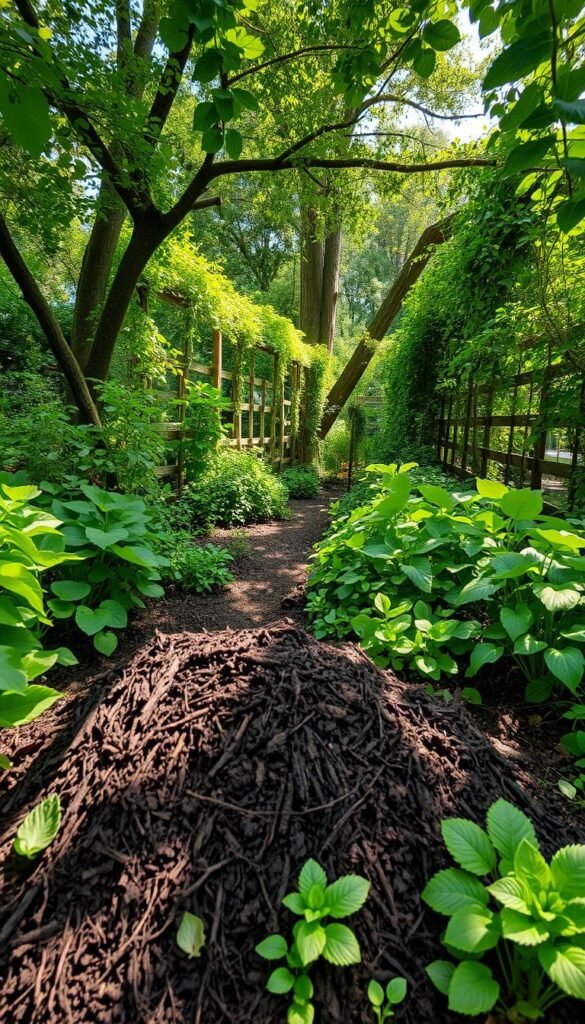Imagine growing fresh vegetables and vibrant flowers without endless weeding or daily watering. This approach rethinks traditional gardening by working with nature rather than against it. By focusing on smart design and soil health upfront, you’ll spend less time maintaining your space and more time enjoying it.
The secret lies in treating your plot as a living ecosystem. Healthy soil acts as the foundation, storing nutrients and water while supporting robust plant growth. Start by enriching your earth through methods like those shared in our guide to organic gardening basics, which emphasizes chemical-free solutions.
You’ll discover systems that practically run themselves once established. Strategic mulching prevents weeds, while companion planting deters pests naturally. Even watering becomes less frequent when you improve moisture retention through proper ground preparation.
This method isn’t just about convenience – it’s about creating lasting abundance. Over time, your efforts yield richer harvests and stronger plants as the land becomes more fertile. The initial investment pays off through seasons of reduced upkeep and increased productivity.
Ready to transform your outdoor space into a resilient food-producing haven? Let’s explore the techniques that turn constant chores into occasional check-ins, giving you freedom without sacrificing results.
Understanding the Essentials of a Self-Sustaining Garden
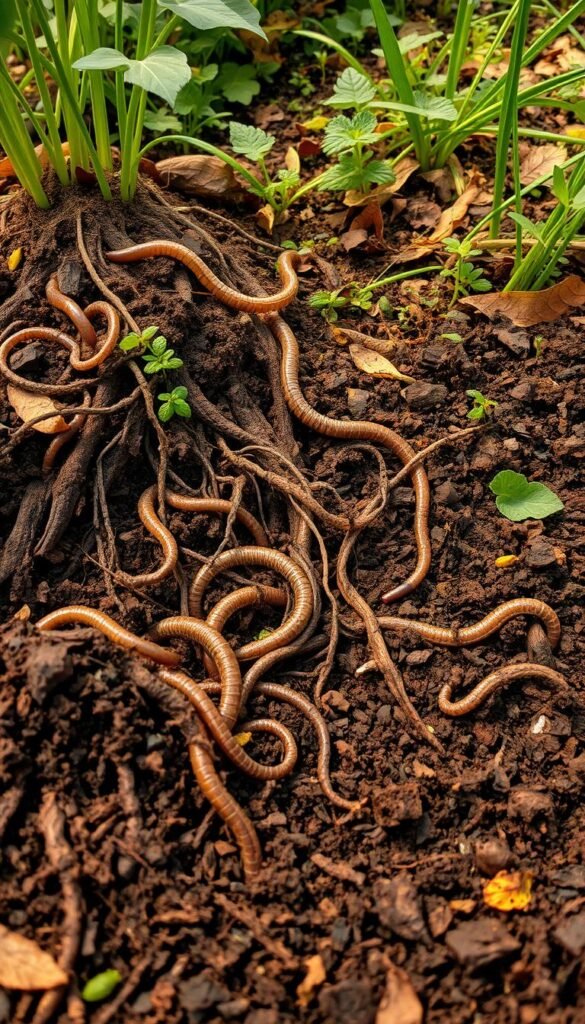
Unlock nature’s blueprint for spaces that thrive through natural cycles rather than constant human intervention. This approach centers on nurturing soil as a living ecosystem – not just dirt, but a bustling community of microbes, fungi, and earthworms working beneath your feet.
Principles of Organic Gardening
Healthy soil forms the cornerstone of self-sufficient spaces. By keeping beds covered with mulch or living plants year-round, you protect delicate fungal networks and prevent erosion. This mimics forest floors where fallen leaves naturally feed the earth.
Diverse plantings create natural pest resistance and nutrient sharing. Try mixing flowers with vegetables – their complementary root systems help cycle minerals while attracting pollinators. Avoid tilling, which destroys the soil food web that feeds your crops.
The Role of Compost and Natural Fertilizers
Quality compost acts like a probiotic for your garden, introducing beneficial organisms that break down organic matter. Unlike synthetic options, organic fertilizers like bone meal or seaweed extracts release nutrients slowly, matching plants’ natural growth rhythms.
After initial setup, consider no-dig methods to maintain soil structure. Layered mulch decomposes into nourishment over time, eliminating the need for yearly compost applications. Your garden becomes a closed-loop system where waste transforms into fuel.
Designing Your Garden Layout for Maximum Sustainability
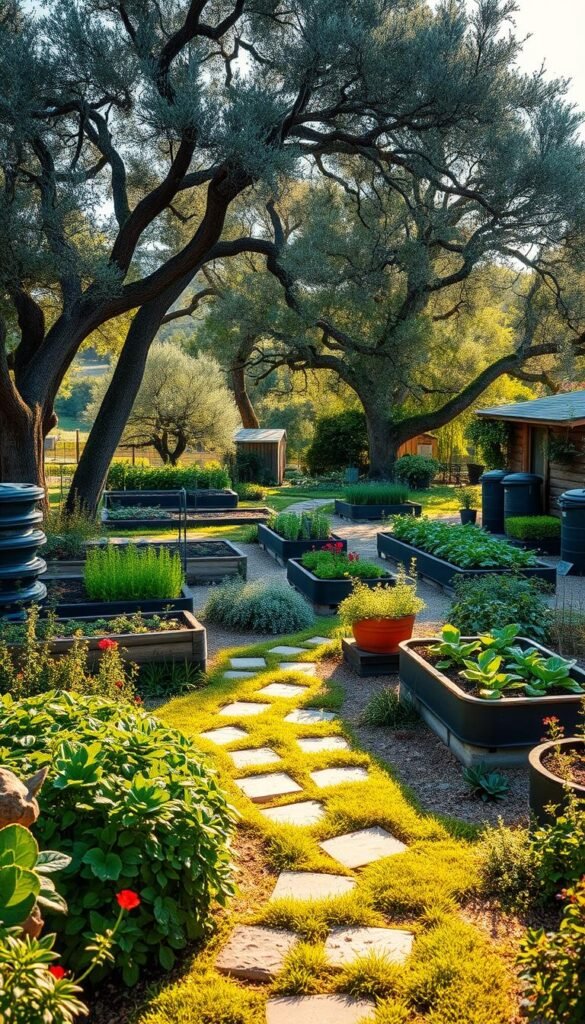
Transform your outdoor space into a thriving ecosystem by mastering layout design that works smarter, not harder. Three core elements form the backbone of self-fertilizing spaces: beds for cultivation, trees for vertical support, and water features that double as wildlife habitats.
Permanent Raised Beds and Pathways
Establishing fixed growing zones eliminates soil disruption. Beds maintain their structure year after year when built using durable materials like stone or rot-resistant wood. For budget-friendly options, explore our guide to building raised beds that stand the test of time.
Pathways between beds should be wide enough for comfortable movement but narrow enough to maximize growing space. Crushed gravel or wood chips prevent mud while allowing water infiltration. This setup protects soil life beneath walking areas.
Integrating Trees and Vertical Elements
Strategically placed trees act as living fertilizers. Their deep roots mine nutrients from subsoil layers, while fallen leaves create natural mulch. Dwarf fruit varieties work beautifully in small spaces, providing shade for heat-sensitive plants.
Vertical trellises turn fences and walls into productive spaces. Pair climbing beans with morning glories – their intertwined growth conserves space while attracting pollinators. This layered approach mimics forest systems, creating microclimates that boost biodiversity.
Building a Healthy Soil Food Web
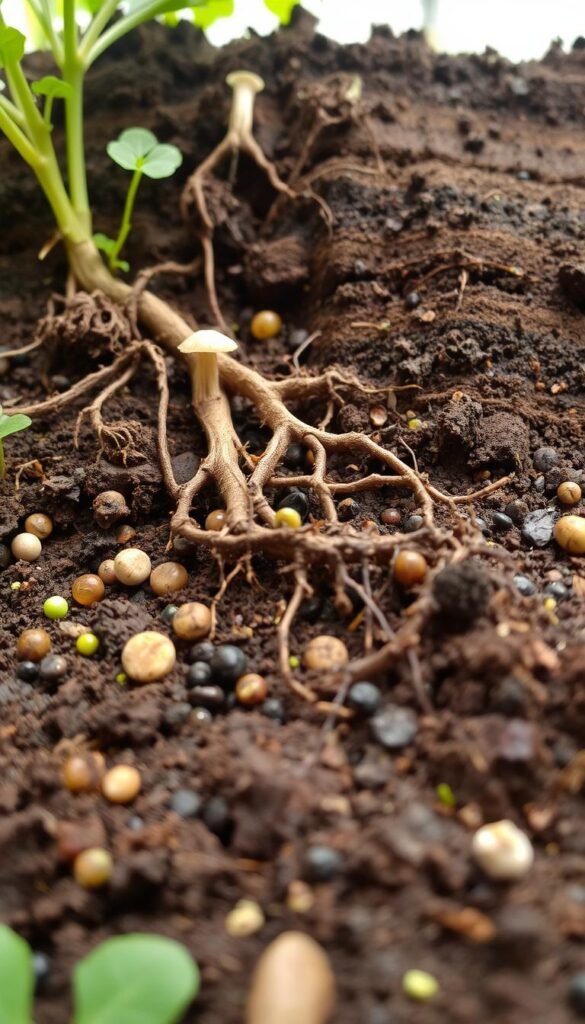
Beneath your feet lies a hidden universe teeming with life. The soil food web connects plants, microbes, and insects in a dance of nutrient exchange and protection. This underground network thrives when you work with its natural rhythms rather than against them.
Encouraging Beneficial Insects and Microorganisms
Invite nature’s pest controllers by planting native flowers near vegetable beds. Beneficial insects like lacewings and ladybugs flock to yarrow and sunflowers. Leave some leaf litter as shelter for ground beetles – they’ll devour slugs overnight.
Water features attract thirsty predators like dragonflies. Avoid broad-spectrum sprays, which harm helpful species. A diverse insect population keeps outbreaks in check without eco-friendly fertilizers losing their effectiveness.
Amending Soil with Organic Matter
Feed your underground allies with compost layered on the surface. This “blanket” approach preserves fungal networks near roots while adding nutrients. Mix deep-rooted comfrey with clover – their contrasting roots mine minerals from different soil depths.
Rotate crops with varying root structures to prevent compaction. Legumes fix nitrogen through bacterial partnerships, while daikon radishes break up hardpan. Your soil becomes richer each season through these natural partnerships.
How to Build a Self-Sustaining Garden with Compost & Natural Fertilizers
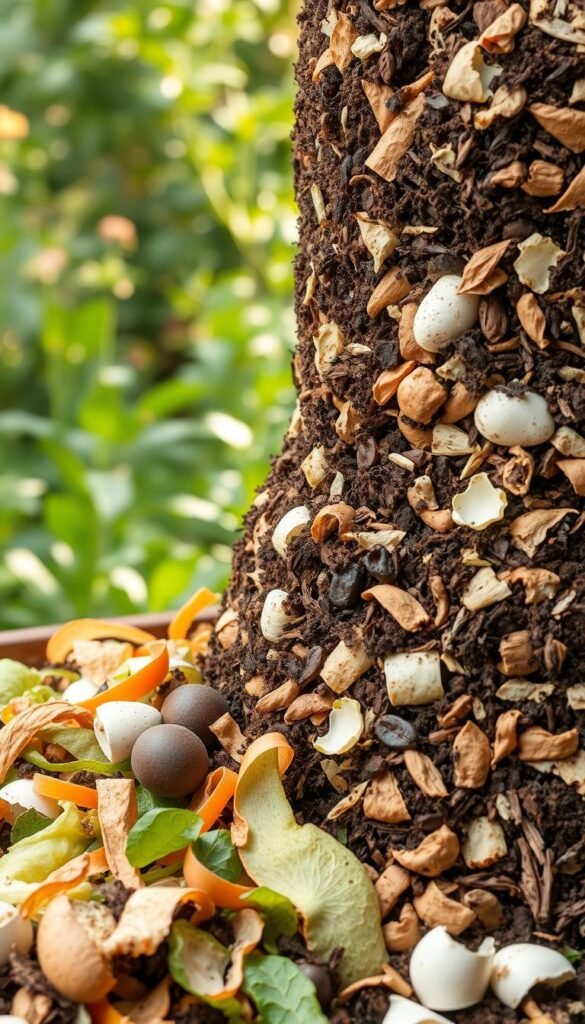
Your garden’s nutritional needs find perfect balance when you harness nature’s recycling system. The right mix of decomposed materials and mineral supplements creates lasting fertility without synthetic inputs.
Starting with High-Quality Compost
Mix equal parts kitchen scraps and dry leaves in layered bins. This compost recipe balances nitrogen-rich “greens” with carbon-heavy “browns.” Within months, you’ll have crumbly black gold that feeds plants and enriches soil structure.
Use finished compost two ways: blend with leaf mold for seed starters, or add handfuls to planting holes for tomatoes and cabbage. Specialized methods like humanure systems safely recycle nutrients for fruit trees when processed correctly.
Selecting Natural Fertilizer Options
Pair your compost with slow-release organic fertilizers for complete nutrition. Bone meal provides phosphorus for flowering, while kelp meal offers trace minerals. Apply these supplements during planting or as side-dressings mid-season.
Test soil annually to identify nutrient gaps. Leafy greens thrive with nitrogen-rich alfalfa meal, while root crops need potassium from wood ash. For detailed guidance, explore our organic garden setup strategies that maximize yields naturally.
Effective Water Management and Mulching Strategies
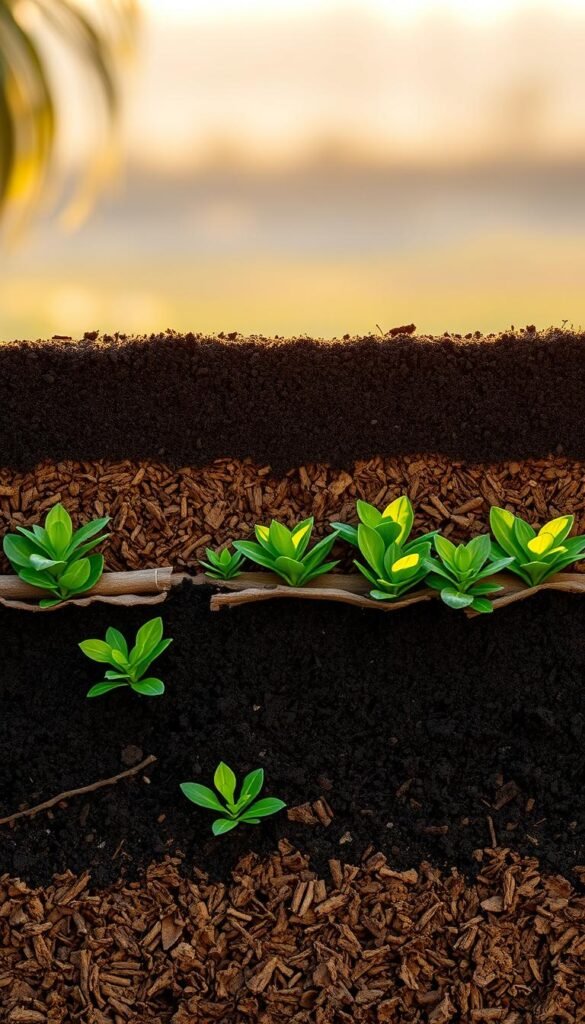
Smart water use and mulch selection can slash your garden chores while boosting plant health. These strategies work together to create resilient growing spaces that thrive with minimal intervention.
Water Conservation Techniques
Layer 12-18 inches of organic material to lock moisture into your soil. This “living blanket” feeds earthworms while reducing watering by up to 80%. Sheet mulching – layering cardboard with straw and leaves – builds sponge-like earth that stores rainfall for weeks.
Design slopes and swales to direct rainwater toward thirsty plants. Berms around fruit trees create mini reservoirs, while shallow trenches between beds prevent runoff. These features turn storms into free irrigation events.
Choosing the Right Mulch for Your Garden
Match materials to your crops’ needs. Straw keeps vegetable roots cool, while shredded leaves acidify soil for blueberries. Grass clippings work wonders around tomatoes but avoid thick layers that could mat.
Refresh mulch seasonally – lighter layers in spring, thicker coverage for summer heat. Always leave space around plant stems to prevent rot. For self-sufficient spaces, use onsite materials like fallen pine needles or spent crop residues.
Natural Pest Management and Encouraging Beneficial Predators
Your garden thrives when predators and prey exist in balanced harmony. Instead of declaring war on pests, create conditions where nature’s security team – beneficial insects – does the heavy lifting. A single praying mantis can devour 20 aphids daily, while ladybug larvae consume 400 pests before adulthood.
Utilizing Insect Allies Like Praying Mantises
Attract these voracious hunters by leaving tall grasses or installing simple wooden shelters. Diverse flowering plants sustain adult mantises with nectar while their offspring patrol your crops. Companion planting marigolds near tomatoes repels root-knot nematodes naturally.
Healthy soil produces robust plants that withstand minor damage. Weak specimens actually help your ecosystem – they become sacrificial lambs that feed predators while stronger crops survive. This natural selection strengthens your garden’s resilience over time.
Avoiding Harmful Chemical Inputs
Synthetic fertilizers create nutrient imbalances that attract pests. They also harm earthworms and predatory beetles working underground. Opt for compost tea sprays instead – they boost plant immunity without collateral damage.
When intervention becomes necessary, use organic options like neem oil only on affected areas. As one master gardener observes: “A few chewed leaves mean your ecosystem is functioning – perfection exists only in grocery stores.” Monitor damage thresholds, acting only if losses exceed 10%.
By fostering this intricate web of life, your space becomes a self-regulating haven. Birds join the pest patrol, while frogs control slugs. Each season brings fewer outbreaks as your garden’s natural defenses strengthen.
Utilizing Organic Fertilizers Made from Everyday Ingredients
Your kitchen holds untapped potential for creating powerful plant nutrition. Common food scraps and cooking byproducts become valuable resources when repurposed as organic fertilizers. This approach reduces waste while delivering essential nutrients to your green spaces.
DIY Liquid Fertilizers with Rice, Pasta, and Vegetable Water
Starchy cooking liquids work wonders for thirsty plants. Cooled rice water provides gentle nitrogen and potassium – dilute 1:4 before applying to seedlings. Pasta water offers similar benefits but requires salt-free preparation.
| Ingredient | Key Nutrients | Best For |
|---|---|---|
| Vegetable Water | Calcium, Magnesium | Leafy Greens |
| Eggshell Water | Calcium Carbonate | Tomatoes |
| Banana Peel Tea | Potassium | Flowering Plants |
Benefits of Coffee Grounds and Banana Peels
Used coffee grounds offer slow-release nitrogen when mixed into soil. They improve drainage in clay earth while mildly acidifying it – perfect for blueberries. For quick use, soak ½ cup grounds in a gallon of water for 48 hours.
Banana peels deliver potassium critical for fruit development. Bury dried peel powder near rose bushes, or ferment chopped peels in water for three days. Combine these methods with other easy organic fertilizers for complete plant nutrition.
Always test homemade solutions on a few leaves first. Rotate different fertilizers to maintain balanced nutrients in your garden’s ecosystem.
Developing a Permaculture Mindset in Your Gardening Approach
True sustainability begins with seeing your space as part of nature’s network. Instead of forcing plants into rigid rows, observe how sunlight dances across your yard or where rainwater naturally gathers. These patterns become your guidebook for creating resilient ecosystems.
Keep a journal to track seasonal changes and plant interactions. Notice which combinations thrive together – maybe your kale grows taller near dill, or marigolds keep beetles away from squash. This thoughtful observation helps you work smarter, not harder.
Focus on building rich soil through layered mulching and minimal disturbance. Healthy earth teems with life that feeds roots and fights diseases. Pair this with native plants adapted to your region – they’ll need less water and attract local pollinators naturally.
For deeper insights, explore permaculture design principles that mimic natural patterns. Create zones based on how often you visit areas, saving energy while maximizing yields. Use vertical layers like dwarf fruit trees and climbing beans to make every inch productive.
Remember: perfection isn’t the goal. A few weeds feed beneficial insects, while uneven growth shows your garden’s adapting to real conditions. Each season deepens your connection to the land’s rhythms, creating spaces that flourish through cooperation, not control.

